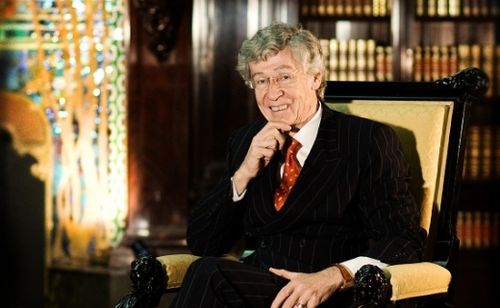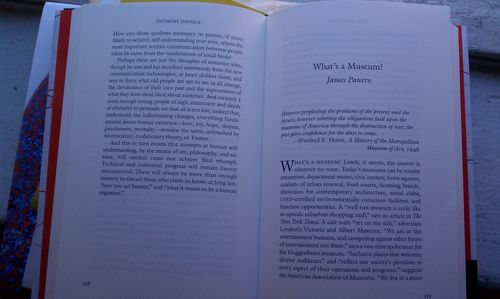
Pat Passlof, Hawthorne (1999, Oil on linen, 87 x 75 inches). Courtesy of Elizabeth Harris Gallery and The Resnick/Passlof Foundation, New York
THE NEW CRITERION
November 2012
Gallery Chronicle
by James Panero
On "To be a Lady: forty-five women in the arts" at the 1285 Avenue of the Americas Art Gallery, New York.
I can pretty much imagine how the show “To be a Lady: forty-five women in the arts” took shape.1 Jason Andrew, the curator of this exhibition of female artists that spans a century and focuses significantly—but not exclusively—on abstract painting and sculpture, has one of the most observant eyes in art. As the director of Norte Maar, a non-profit apartment gallery in Bushwick, Brooklyn, he has probably surveyed more of the outer-borough art scene than any other curator. As something of a neighborhood impresario, he has most likely seen more Bushwick-based art than anyone else, period. According to one challenge he issued to himself on Twitter, he recently tried to visit every open studio during Bushwick Open Studios weekend. (An impossible task that would have left little more than a minute per venue, including travel time; he still far outpaced the rest of us.)
Andrew has an inclusive eye but also a discerning one, and it has taken him far beyond Bushwick. He is the manager of the estate of Jack Tworkov, the first-generation Abstract Expressionist, and has curated landmark shows of the artist. He has produced art-infused dance performances choreographed by Julia K. Gleich. He has mounted historical exhibitions about the arts of Black Mountain College, and of the artists who passed through the Wells Street Gallery, an avant-garde gallery in late-1950s Chicago. He has hosted a series of events around the centenary of John Cage. Several of these projects have been covered in this column.
Andrew has a gift for seeing the essential qualities of art. He can look past what’s marketable to uncover what shines. He unearths art that projects a personal, often mystical, light. He sees connections between art works that cut across geography and time, adding his own energetic voice to the resonances that exist between the 1950s vanguard and what we see on the vital periphery of art today. This is a vision Andrew has been generous enough to share, and one that has influenced my own view of art.
I said I could imagine how his current show came together, because it probably started with an observation I have similarly made while surveying this artistic landscape: much, maybe most, of the art that interests me these days is by women.
Brooke Moyse (b.1978), Mount (2011, Oil on canvas, 72 x 80 inches) Courtesy of the artist. Photo: Jason Mandella
For me, I must say, this kind of thought sets off neither a light bulb nor an alarm bell but instead the klaxon voice of my mother, a 1970s-era feminist. What do you mean? Why would you notice? Why shouldn’t it be? And on it goes until the thought shuts down in ear-splitting mental agony.
It is regrettable that our culture today does not seem any better equipped to discuss such sexual distinctions. Even when elicited, such talk often devolves into giggles or indignation. So Andrew should be applauded for taking this observation and making something big of it. “It is not the intention of this exhibition to be a comprehensive survey of women in the arts,” he writes. “It’s a selection of artists I know, have come to respect, and whose aesthetic I admire.”
To be a Lady” is not a scholarly exhibition or one that makes a single explicit claim. It mainly comes across as a show of Andrew’s personal taste, telling the story of his own wandering eye—just one that separates the ladies from the gentlemen. It circles through the Tworkov era, with several works by artists born, like Tworkov, at or near the turn of the last century. This includes Alma Thomas (1891–1978), Charmion von Wiegand (1896–1983), Louise Nevelson (1899–1988), Alice Neel (1900–1984), Barbara Morgan (1900–1992), Irene Rice Pereira (1902–1971), Janice Biala (1903–2000), May Wilson (1905–1986), Lenore Tawney (1907–2007), and Louise Bourgeois (1911–2010). The Wells Street group is also represented, here by Judith Dolnick (born 1934).
Judith Dolnick (b.1934), Untitled (2012, 52 x 108 inches, Acrylic on canvas) Courtesy of the artist.
Then there are many familiar names from Andrew’s Bushwick—artists who either live, work, or exhibit in the neighborhood. A partial list, which includes Mira Schor (b. 1950), Mary Judge (b. 1953), Tamara Gonzales (b. 1959), Brece Honeycutt (b. 1960), Julia K. Gleich (b. 1965), Austin Thomas (b. 1969), Ellen Letcher (b. 1972), and Brooke Moyse (b. 1978), signals the wide range of artists who are now associated with this scene. All told, the works on display, which fill both sides of the bustling and often distracting lobby of the UBS Building in midtown, come from personal loans, Andrew’s own collection, and two dozen or so galleries and estates that are within Andrew’s orbit.
More than just mounting a personal show, however, Andrew recognizes that the distinction at the heart of “To be a Lady” says something, even if he is not altogether sure quite what. Is this an exhibition of women, a show about women, or a survey that happens to be made up of women? Are women artists the overlooked equals of men, or do they have their own separate story to tell? In trying to answer, Andrew gets lost in the weeds, perhaps understandably so, because the answer to all of these questions is yes.
In his catalogue essay, Andrew explains how the title, “To be a Lady,” is meant to be taken ironically, deriding how artists like Joan Mitchell were once brushed aside, so to speak, as “lady painters.” Yet at the same time, the title seems to suggest that there might, in fact, be something decorous and “lady-like” in what these artists do. Through their art, these women define what it means to be a lady, and maybe that’s not such a bad thing after all. As someone who has gotten to know many of the younger artists in this exhibition, I can say that they are indeed upstanding ladies—far superior to the drunks, deadbeats, and louts that have made up much of the male art mafia over the past hundred years. (I hasten to add that, contrary to this historical group, the male artists I know are almost all perfect gentlemen.)
Andrew further writes how “gender rarely factors into my curatorial criteria,” yet “these women have problematized and played with gender identifications and characterizations, from lady to woman to other in some form, consciously or unconsciously.” He writes that his exhibition brings together artists “who happen to be women.” He quotes Lee Krasner, who said, “I’m an artist not a woman artist.” It’s a sentiment that seems to be shared by many of the artists here on view. Yet Andrew also says that these happen-to-be-women artists burst open “the once taboo subjects of politics, societal roles, sex, and gender with their work.”
Part of the confusion here may lie in the way political feminism has controlled our sex-based dialogue, all while trailblazing women into an artistic ghetto. Feminist art might now take pride of place in the Elizabeth A. Sackler Center at the Brooklyn Museum, where Judy Chicago’s The Dinner Party, a feminist Seder table with vagina-themed place settings, takes up the museum’s attic. But this arch work only extended the most hyperbolic qualities of over-sexed macho art. It sent Picasso’s dentata to the orthodontist and felt satisfied with newly straightened teeth.
And just as the meteoric rise of the New York School at mid-century obscured, rather than illuminated, the great abstract artists who both preceded and came after, so too has the era of feminist art, centered in the 1970s, done little to highlight artists who happen to be women but never happened to be feminists. (Here I am reminded of a story the legendarily tough critic Dore Ashton recently told me about receiving a delegation of feminists, “a very unattractive group of ladies in leather jackets and what-have-you. And I said very sweetly, ‘I’m not going to join you. The day you start advocating for working-class women, I’ll join you,’ and they never did.”)
The fact is that feminism has largely been the sideshow, rather than the main event, for women in the arts. That’s why Andrew’s handful of political inclusions in “To be a Lady” largely seem like distractions from the main event. Cod Variations: Hoop Dreams (Large) (2009), by Michelle Jaffé (b. 1956), claims to evince the “hubris of a nation, suggesting the Logo, Branded Identity, and caricature of the Cartoon Action Hero.” Yet this sculpture of plastic mesh suspended from a basketball hoop in the shape of a protective cup is more a rim shot than a slam-dunk. So too is Amnion Folds (2003), a photo collage of rolled skin by Genesis Breyer (b. 1950), a professional (ahem, male) gender-bender whose one-time project was to have extensive plastic surgery so he could resemble his wife.
These examples aside, what “To be a Lady” mainly suggests is that sexual difference means more than nothing and less than everything in art. That’s a wide area to operate in, and it should be, because being a lady (or being a gentleman, for that matter) is one of the great assets informing an artist’s individuality.
It’s too bad that the language of music cannot apply to visual art. We all know there’s a difference between a tenor and a soprano, yet we value them equally. In fact, opera is rather dull without both. The same holds true for the voices of painters or sculptors. With its concentration of abstract artists, “To be a Lady” suggests, in particular, why women’s voices have been essential to the evolution of modernism. Even without pivotal figures on display like Helen Frankenthaler, the lady who made the men look like boys, “To be a Lady” suggests how women have advanced an abstract language that is thankfully free of distracting male quavers. Without macho bluster, the works here can settle into contemplative, often symmetrical compositions.
That’s why we can see connections back and forth across generations between Red Scarlet Sage (1976), Alma Thomas’s tessellated, terrazzo patterns in paint, and Round Place Square (2010), Austin Thomas’s intricate, magical collage. The mystical radiance of Invocation to the Adi Buddha (1968–70), by Charmion von Wiegand, reappears in the prismatic topography of Mount (2011), by Brooke Moyse, which further reflects the sculptural light of Hawk (2012), by Rachel Beach. Soft Star Series, No. 6(2007), Mary Judge’s delicate mandala of powdered pigment, speaks toUntitled (220-09) (2009), Hermine Ford’s Byzantine tile fragment in oil.Untitled (c. 1960), Lee Bontecou’s haunting wall sculpture, reacts toHawthorne (1999), Pat Passlof’s forceful testament to how a painting can bend and fold (my favorite single work in the show).
For every example here, there are ten others that could be included and would be equally worthy, from Dee Shapiro to Judith Braun, Lori Ellison to Julie Torres. One issue is that the UBS lobby is something of a corporate—dare I say, masculine—space, and so much of the art by women that I see these days is of a more intimate—dare I say, domestic—scale.
“For women in the arts,” writes Andrew, “as in many other fields, a special fortitude and commitment can be seen in the work and lives of those who succeed.” He’s right, but this statement could also apply to almost all artists, ladies and gentlemen alike, who work against convention to make art of significance. It’s just that the women who succeed in art have worked against more, and their art has often been better and more nuanced than the boys’ because of it.
1 “To be a Lady: forty-five women in the arts” opened at the 1285 Avenue of the Americas Art Gallery, New York, on September 24, 2012 and remains on view through January 18, 2013.











